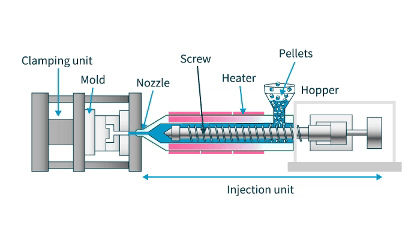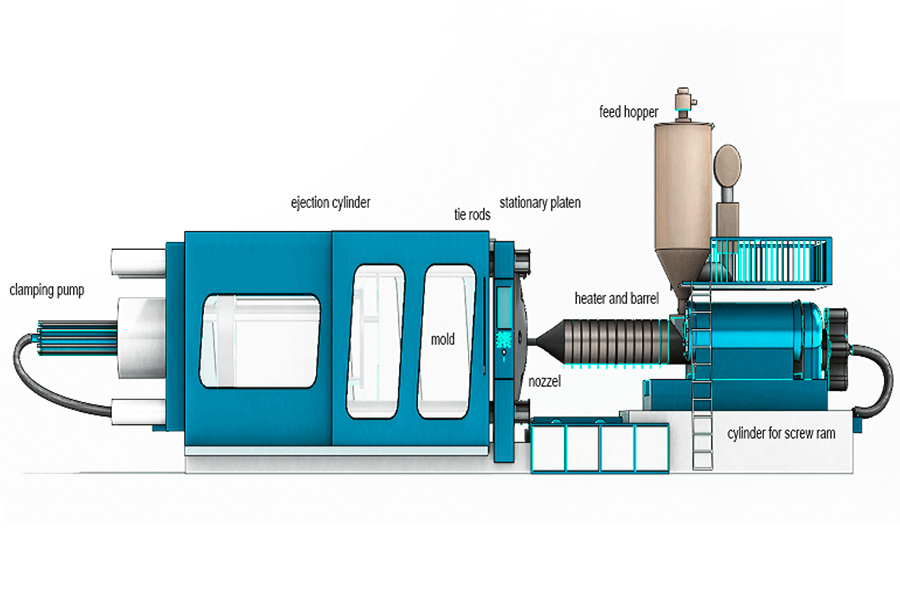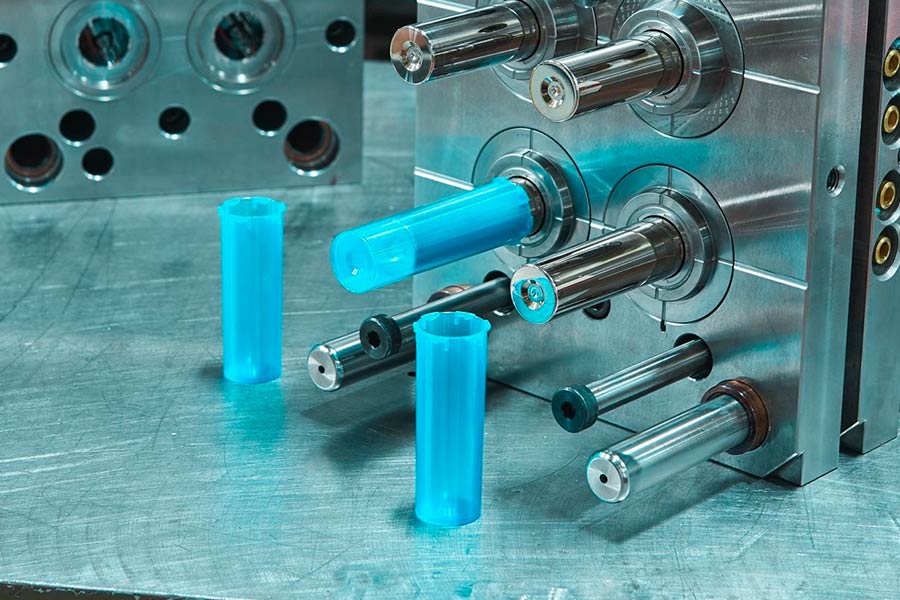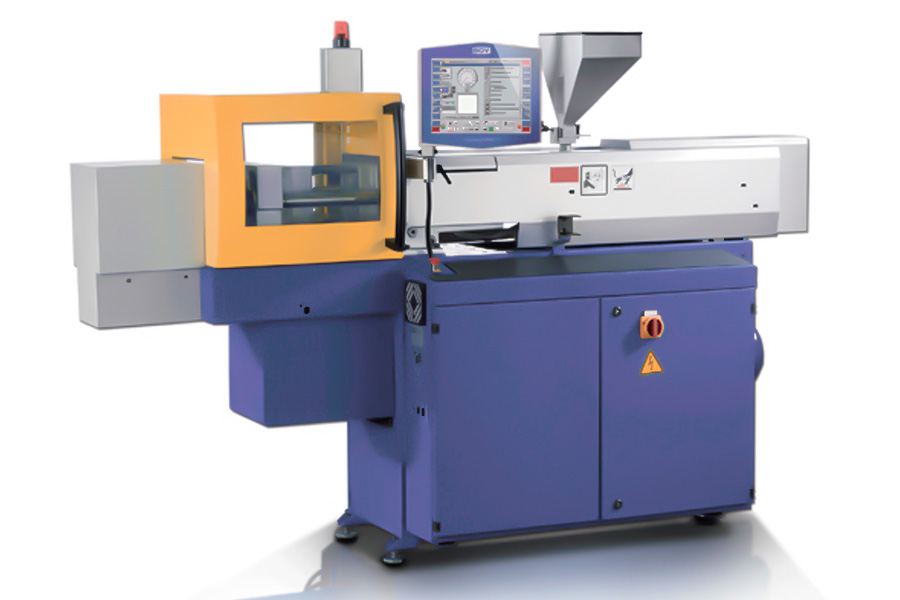Injection molding, as a typical representative of molding meaning in modern industry. It is a mass production process in which polymer molten materials are injected into precision mold under high pressure and cooled and solidified to form complex components. Its core is to combine the thermodynamic mechanism of molding injection with mechanics properties to achieve the dimension accuracy and surface mass of millimeter and even micron scale through precise control of temperature, pressure, filling rate and other parameters.
With the transformation of global manufacturing to high efficiency and intelligence, molding technology has broken through traditional framework and developed into comprehensive innovations such as 3D printing preforms and biodegradable materials. This paper will analyze the workflow of injection molding, mold design and the role of injection molding machines to provide theoretical reference and practical inspiration for the industry's technological upgrading of the industry.

What is the science behind injection molding?
The scientific essence of injection molding is the precise injection of molten polymer materials into mold cavity and their solidification through the synergy of thermodynamics, fluid mechanics and materials science. The scientific control of molding injection process depends on the dynamic adjustment of core parameters of injection molding process.
1.Thermodynamics drive
During injection-molding process, plastic particles are cut by screws and then melted by heaters to form a viscoelastic fluid whose viscosity varies exponentially with temperature. The key to scientific control lies balancing mold temperature (usually controlled at 20-150°C) with melt cooling rate. Rapid cooling can shorten the cycle but easily cause warping deformation, while slow cooling can increase crystallinity but reduce production efficiency.
2.Hydrodynamics dominates
The flow of molten material in molten cavity follows the characteristics of non Newtonian fluid characteristics, and the pressure gradient is proportional to the square of flow velocity. Scientific control requires the melt shear rate to be regulated by screw speed (usually 100-500rpm) to prevent fiber-reinforced material from breaking due to excessive shearing. At the same time, the gate is designed to match the fluidity of the material (e.g. PP's melt flow index MFI=20-30g/10min), ensuring that the front of the melt is evenly filled in a laminar flow mode to avoid a decrease in the strength of the melt line.
3.Building Materials Science Capacities
The final properties of injection molding depend on the evolution of the material's microstructure. ABS resins, for example, undergo molecular chain entanglement and recombination during the pressure retention phase (pressure 80-120 MPa), with a positive correlation between impact intensity and retention time. By monitoring melt temperature difference and pressure fluctuations in real time by mold sensors, process parameters can be optimized and the tolerance of car bumper parts can be controlled to ±0.1mm.
4.Intelligent control
Modern injection-molding technology combines digital twin with machine learning to achieve automatic iteration of injection molding parameters by setting up injection molding parameter optimization model.
How is injection molding gradually carried out?
Injection molding is one of the core technologies of modern manufacturing industry. It is widely used in plastic molding and silicone molding. The key steps for its progressive implementation are as follows:
1.Design and documentation
Customers are required to submit CAD drawings in STEP, STL, PDF, etc. The JS team will conduct simulation analysis through specialized software to assess the feasibility of the product structure and make optimization suggestions. This phase can reduce the cost of subsequent modifications by 30%.
2.Precision mold manufacturing
- Material choice: Adopt Imported high-quality steel (e.g. H13, S136), mold life more than 1 million cycles.
- Structural Design: According to the characteristics of plastic molding and silicone molding, hot and cold flow systems are adopted respectively.
- Fast delivery: JS's standardized process shortens the mold manufacturing cycle to 2 to 4 weeks and supports small batch customisation.
3.Material selection and pretreatment
- Plastic molding: Supports more than 50 plastics such as ABS, PC, PA, TPU, and requires drying and colouring according to material characteristics (e.g. PET, 4 hours at 120°C).
- Silicone molding: Using medical-grade or food grade liquid silicone (LSR), the premix needs to be adjusted in a vacuum to avoid bubbles.
- JS's automated feeding system can control material ratios accurately and reduce human error.
4.Parameter control of injection molding process
Temperature management: Injection molding machine nozzle temperature is set at a material melting point of +20 °C and the mold temperature (± 1°C fluctuation) is precisely controlled through a circulating water circuit or an oil thermostat.
Pressure regulation:
- Plastic molding: Injection pressure is generally 50-150MPa, which is maintained during the holding phase to prevent shrinkage.
- Silicone molding: Use low pressure injection molding (10-30MPa) to adapt to the flowability of silicone, prolong the insulation time, ensure uniform filling.
5.Post-treatment and quality inspection
- Disassembly technology: Automatic disassembly by ejector pins, pneumatic disassembly or robotic arm to reduce manual intervention.
- Surface optimization: Provides value added services such as polishing (Ra ≤0.02μm), spraying, plating, etc. For example, JS's matte texture technology for car interiors can reduce gloss by up to 80%.
- Quality inspection Standard: The key dimensions tolerance is controlled within ±0.005mm using CMM and X-ray inspection.

What is mold design?
Molding design is the cornerstone of plastic moldings. Its essence is to establish a mold system that can produce molding plastic parts efficiently and stably through precision engineering and materials science. In the field of plastic moldings, the quality of mold design directly determines the size accuracy, surface quality and production cost of the product. JS company took the technology to the next level with its deep experience in molding design.
Core elements of mold design
1.Structural Design: Modeling and optimization of die cavity, flow channel and cooling system are needed according to the fluidity and shrinkage rate of modeling plastic. For example, JS uses mold-flow analysis software to simulate the flow path of the melt, limiting the filling time error to ±5% to avoid understrength or weld warping deformation.
2.Material selection: Die steel requires a balance of hardness and heat resistance. For example, P20 steel is used for common plastics and H13 steel is used for high temperature materials (e.g. PEEK). JS uses surface nitrogen treatment technology to increase the die's service life to more than 1 million cycles, reducing long-term production costs for customers.
3.Precision machining: Five axis CNC machine tools combined with EDM and meets the strict requirements of medical grade plastic molding,such as surgical instrument casings.
JS Company's Molding Design Technology Advantage
1.Intelligent Design: An AI algorithmically integrated mold design platform automatically generates the most gate position location and cooling layout, shortening development time 40%.
2.Multi material adaptation: Differential mold solutions that support thermoplastic materials (e.g. ABS, PC) and elastomers (e.g. TPU, silicone). The design of JS's silicone moldings adopts tear resistant structure design, and the successful removal rate up to 99%.
3.Sustainable manufacturing: Modular mold design enables rapid mold replacement and material recycling, reduces waste generation by 30% and is in line with global environmental trends.
How to achieve a balance between the lifespan and cost of injection molds?
1.Design phase
- Modular design: Breaking down the die into standard components (such as sprue sleeves and ejector pins) and customized components reduces development lead times by 30%.
- Case: Modular design of a car connector mold, up 70% reuse rate, over 800,000 times service life, 25% reduction in unit cost.
- CAE simulation optimization: Modeling melt flow with die flow analysis software, predicting stress concentration areas, optimizing structure.
- Effect: The repair rate of JS molds due to design defects is only 5%, compared with the industry average 15%.
2. Material selection
- Material grading strategy
| Scene | Material type | Lifespan (10,000 cycles) | Cost proportion |
| Automotive precision components | Imported H13 steel | 80-120 | High (30%-40%) |
| Daily Shell | Pre hardened tool steel | 30-50 | Medium (20%-30%) |
| Medical silicone components | Silicone specific alloy steel | 50-80 | High (35%-45%) |
- Surface treatment technology: PVD/TiN coating or laser cladding is used to improve abrasion resistance and avoid overinvestment in high-priced steel.
3.Lean Manufacturing and Technological upgrade
- Intelligent machining system construction: Using five axis linkage CNC machine tool and real-time on-line measurement system, mold correction frequency is controlled to less than 5%.
- Process efficiency breakthrough: Through process parameter optimization and equipment linkage control, the single-mode processing cycle was shortened by 20%, while the ultra-low defect rate of less than 0.3% was achieved.
- Innovation of heat flow channel system: Using multi-cavity heat flow channel to balance feeding technology, reduce the cold material head produced by the gate by 70%, and extend the wear cycle of key parts of molds by 30%.
4. Smart Monitoring and cost optimization solution
- The sensor network monitors mold temperature and pressure data in real time, using artificial intelligence algorithms to predict the wear cycle of key components for preventive maintenance.
- Application examples show that predictive maintenance can reduce unplanned downtime of household appliance mold by 60% and extend its service life by 20%.
- Whole life cycle cost model: Comprehensive evaluation of R&D, production losses, operation maintenance, etc., to avoid deviating from a single initial investment decision.
- Comparison:
| Scheme | Initial cost | Lifespan (10,000 cycles) | One time cost |
| Standard mold |
$5,000
|
20 | $0.25 |
| JS optimization plan | $8,000 | 50 | $0.16 |
5. Balance Strategy Summary Table
| Core elements | Balance measures | Typical effect |
| Design optimization | Modular design, CAE simulation. | Reduce development cycle by 30% and maintenance by 10%. |
| Material selection | Graded material selection+surface treatment. | Increase lifespan by 2-3 times, reduces long-term costs by 15-20%. |
| Manufacturing process | High speed machining+hot runner technology. | Process efficiency increased by 20% and yield rate exceeded 98%. |
| Maintenance | Monitoring+preventive maintenance | Reduce downtime by 60% and extend service life by over 20%. |
JS Company Practice Case:
- Car dashboard die: Made with H13 steel and hot runner system, it has a service life of 800,000 cycles and annual maintenance cost of less than $2,000.
- Consumer electronics shell mold: Pre-hardened steel+modular design with 300,000 times service life and no more than 15 minutes of mold change time.
- Medical silicone mold: Special alloy steel + corrosionresistant coating with a service life of 500,000 times and a failure rate of less than 0.01%.

How do the core components of an injection molding machine work together in terms of their respective functions?
Division of functions among core components
1.Injection unit
Function: Heat and melt solid plastic particles and inject mold cavity under high pressure (50-200MPa).
Key technologies:
- Screw drive: Plasticized and measured by screw rotation and propulsion (e.g. JS's servo motor drive system, injection accuracy ±0.5%).
- Temperature control: Segmented heating coils ensures uniform melt temperature (e.g. nylon material requires constant temperature of 260-280°C).
- Performance indicators: Injection speed up to 80mm/s, suitable for thin-walled packaging, thick-walled auto parts and other requirements.
2.Mold closing system
Function: Provide sufficient locking force (such as JS model up to 1200 tons) to prevent injection molds from cracking under pressure and complete opening and closing action of injection molds.
Key technologies:
- Hydraulic drive: Adjust oil pressure through proportional valve to achieve accurate locking force control (error less than 5%).
- Mold adjustment mechanism: Mold thickness can be adjusted automatically according to different production specifications (e.g. JS electric mold adjustment system, mold adjustment accuracy ±0.01mm).
- Performance indicators: Support multiple mold sizes (minimum 50×50mm, maximum 1500×1500mm).
3.Control system
Function: Coordinate the timing and sequence of injection molding, compression, cooling, mold opening, etc. to ensure the stability of process parameters.
Key technologies:
- PLC Programming: Supports customization of production processes (e.g. multistage injection molding, delayed mold opening).
- Data collection: Real-time monitoring of parameters such as pressure, temperature and location (system sampling frequency up to 1000Hz in JS system).
- Performance indicators: Circulation time can be shortened to 1.5 seconds (high speed model) with a yield ≥98%.
Collaboration of the three main components
1.Mold closing stage
- The mold closing system shuts down the die and the hydraulic cylinder exerts locking force (200 tons of locking force is required, for example, for the mold of the cell phone case).
- The control system detects the closing state of the die and triggers the injection signal.
2.Injection stage
- The injection unit screw is pushed forward and molten plastic is injected into the mold (e.g. PET preforms 120MPa) at a set pressure.
- The control system adjusts the screw speed (segmented acceleration) and retention time (e.g.10 seconds for car parts).
3.Cooling and mold opening
- The cooling water circuit carries heat through the mold and the control system monitors the mold temperature (e.g. ±1℃ fluctuation).
- When the pre-set cooling time is reached, the mold closing system opens and the ejection mechanism pushes out the finished product.

How can JS material database help customers shorten the material selection cycle?
1.Intelligent screening and matching
- Parameterized query: Supports rapid filtration by material type (e.g. ABS, PA66, liquid silicone), mechanical properties, processing process (injection temperature, mold steel adaptability), etc.
- Case matching: Based on project history data, successful material solutions are directly recommended for similar situations.
2.Performance visualization comparison
- Material comparison matrix: Detailed parameters such as shrinkage rate, thermal deformation temperature and impact strength of 50+ plastic materials, 20+ silica and composite materials are compared by graph.
- Real-time simulation feedback: linked to mold flow analysis software to predict material flow behavior and cooling efficiency in a particular die.
3.Industry certification and compliance
- Standardized labeling: Indicates whether the material complies with FDA, RoHS, UL, and other certification requirements (such as biocompatibility certification for medical-grade silicone), reducing customer self verification time.
- Eco-friendly materials exhibition area: Concentrated display green materials such as biodegradable plastics (PLA) and recycled PET to support sustainable development needs.
4.Advantages of JS Material Database
| Dimension | Pain points of traditional material selection | JS database solution |
| Efficiency | Manual data retrieval takes 3-5 days. | Initial screening of materials completed in 10 minutes. |
| Accuracy | Reliance on experience judgment, prone to error. | Double validation of data and simulations with error rate of less than 5%. |
| Cost | High cost of trial and error (material waste+mold modification). | Virtual testing reduces physical experiment costs by 80%. |
| Compliance | Verification standards are subject to verification on a case-by-case basis. | Direct labelling of compliance labels to avoid legal risk. |
Summary
Injection molding realizes efficient transformation of plastic particles into complex components, and its technical value is reflected not only in the ultimate exploration of material properties, but also in the deep fusion of molding design and injection-molding processes. Through intelligent parameter control, modular mold development and digital production process, injection molding not only reduces the cost, but also endows the product with higher accuracy and reliability. In the future, with the improvement of algorithm optimization and automation level, injection molding technology will continue to push the boundaries and become a key force driving product innovation and industrial upgrading.
Disclaimer
The content of this page is for informational purposes only.JS SeriesNo representations or warranties of any kind, express or implied, are made as to the accuracy, completeness or validity of the information. It should not be inferred that the performance parameters, geometric tolerances, specific design features,material quality and type or workmanship that the third-party supplier or manufacturer will provide through the jusheng network. This is the responsibility of the buyerAsk for a quote for partsto determine the specific requirements for these parts.please Contact us Learn more information.
JS Team
JS is an industry-leading companyFocus on custom manufacturing solutions. With over 20 years of experience serving more than 5,000 customers,we focus on high precisionCNC machining,Sheet metal fabrication,3D printing,Injection molding,metal stamping,and other one-stop manufacturing services.
Our factory is equipped with more than 100 state-of-the-art 5-axis machining centers and is ISO 9001:2015 certified. We provide fast, efficient and high-quality manufacturing solutions to customers in more than 150 countries around the world. Whether it's low-volume production or mass customization, we can meet your needs with the fastest delivery within 24 hours. chooseJS TechnologyIt means choosing efficiency, quality and professionalism.
To learn more, please visit our website:jsrpm.com
FAQs
1.How important is mold design?
Mold design directly influences the shape, dimension accuracy and surface quality of the product. Good design can reduce shrinkage and deformation and improve production efficiency.
2.How to choose the right plastic material?
Materials such as ABS (durable) and silicone (soft) for sealing ring are selected according to product usage. Material performance determines processing temperature and finished product performance.
3.How do injection molding machines work?
The injection molding machine melts plastic particles by heating them and then injects them into the mold at high pressure. Once cooled, open the mould and remove the finished product. Its core components include injection unit, mold clamping system and control system.
4.How to reduce pollution during injection molding process?
Plastic injection molding can be effectively reduced by adopting recycled plastics (e.g. PCR materials), optimizing process parameters, reducing waste, installing exhaust gas filtration devices, adopting heat flow systems and reducing raw material losses.
Resources






